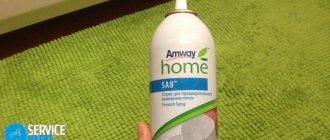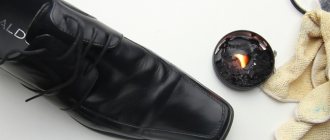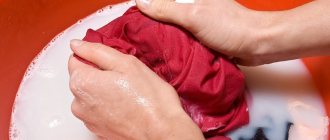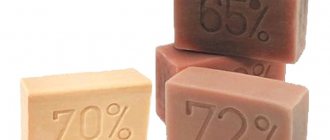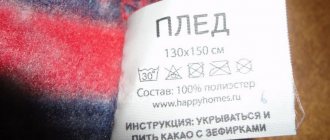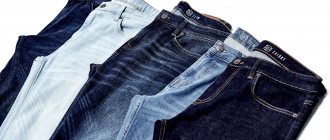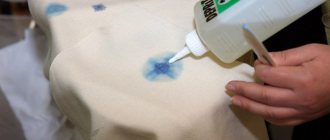It is impossible to imagine a person who does not have a single T-shirt in his wardrobe. This clothing is very comfortable, practical and perfect for an informal setting. In it you can calmly go to a feast, and to the world, and to good people. Therefore, it is not surprising that quite often you can find various stains on a T-shirt that cannot be removed. However, there is nothing complicated about it. Next, we will look at how to properly wash a T-shirt so that it always looks perfect.
Machine washable
To determine in what mode the T-shirt should be washed, you need to look at the label sewn on the wrong side of the product. It contains all the necessary information on clothing care. If there is no prohibition sign on the label, you can wash the T-shirt in the washing machine. In this case, you must be guided by the following rules:
- If there are visible stains on the T-shirt, you will need to first soak it for twenty to thirty minutes in a soap solution. To prepare it, you can use any suitable detergent.
- Before you machine wash your T-shirt, you need to turn it inside out.
- It is better to wash the T-shirt separately. However, it is allowed to load small items with it, such as underwear and socks.
- It is better to load liquid detergent into the container for washing powder, since such household chemicals are much easier to wash out of the fabric.
- The number of revolutions should be minimal.
- Delicate items should be washed with the spin and automatic drying switched off.
Expert opinion
Evgeniy Taran
Please note that experts recommend washing new T-shirts immediately after purchase. This is necessary so that the clothes do not become dyed during subsequent washes.
Clothes must not only be washed, but also dried properly. Most housewives do not know how to quickly dry a T-shirt. Therefore, they are trying to do this with the help of batteries and household heaters. However, if you dry a T-shirt in this way after washing, it may lose its original shape and size. It is better to let the excess liquid drain and hang the clothes outside to dry.
Preparing for washing
Preparing a T-shirt for cleaning includes the following steps:
- study the label;
- we take into account the subtleties: is there a collar, embroidery, color print, appliqué;
- determine the washing mode;
- choosing a cleaning product;
- remove stains.
T-shirt label
Accurate determination of the material from which the T-shirt is made will help you choose the washing mode:
- Plain cotton T-shirts will withstand any cleaning process: machine or manual mode, temperatures up to 60 degrees, the use of bleaches and stain removers, spinning at high speeds, drying on a clothesline and ironing with a hot iron.
- Cotton items with lycra need a more gentle approach: temperature up to 40 degrees, delicate machine wash, low drum speed. The best option is manual cleaning without twisting or stretching.
- Woolen and knitted T-shirts are the most capricious; they require manual processing, gentle cleansing gels, cool water, gentle stain removal, gentle spinning and drying.
Important! The product label indicates the manufacturer's care recommendations. They will help you avoid making mistakes with the choice of washing mode, temperature, drying method, and iron heating level.
Consistent adherence to all stages will help you choose the optimal washing method and maintain the cleanliness and integrity of your items.
How to wash by hand
Washing T-shirts and tank tops by hand is quite easy. Let's consider the procedure for performing a hygiene procedure:
- First you need to place a basin in the bathtub and fill it with water.
- Then load a suitable washing powder or washing gel into it.
- When the soap solution is ready, you should immerse the T-shirt in it and leave it to soak from the dirt for fifteen twenty minutes.
- After this time, rub the fabric intensively, paying special attention to the armpits and collar area.
- At the end of the hygiene procedure, you will need to rinse the product two or three times in water at the same temperature as it was at the beginning. This is to prevent the T-shirt from stretching or shrinking after hand washing.
Important! Products with rhinestones and sequins are best washed by hand.
Recommendations
Expert advice on washing T-shirts will help you keep your item in order and preserve its appearance.
Important recommendations include the following:
- If the T-shirt has decorative or functional fasteners (buttons, zippers), they must be fastened before washing.
- Stains that are on a worn item must be removed before the main wash, and not after it.
- It is recommended to wash colored items no more than 3 times after dressing, and white items no more than 2 times.
- If items have rhinestones, complex appliqués, etc., they should not be caught with the tip of the iron during ironing.
- Adding a couple of tablespoons of vinegar to the rinse water will help maintain the brightness of the shades.
- Hand washing should preferably be done with rubber gloves.
At what temperature should I wash?
Before you start washing your T-shirt, you should decide at what temperature the procedure should be carried out. This is due to the fact that if the temperature is incorrectly selected, the product stretches or, conversely, becomes a size or two smaller. Let's consider in what water you need to wash T-shirts made from different fabrics:
- Clothing made from cotton or linen can be washed in both cool and hot water - this will not reduce it in the least.
- Products made from wool or silk are washed at temperatures below thirty-five degrees to avoid shrinkage. If you violate this rule, you may find that the T-shirt has shrunk after washing.
- Viscose can be washed in water whose temperature does not exceed thirty degrees.
- Synthetic items should be washed in warm water - from forty to fifty degrees.
Features of hand washing
In order to wash a T-shirt by hand, dilute the detergent in warm water in a prepared basin, bucket or other container, making sure that it is completely dissolved. If necessary, the item is soaked for a while, if the fabric allows.
The material is crumpled with light movements, lifted and lowered, trying not to rub or squeeze too much.
Rinse in several waters, trying not to change the water temperature much so that the fabric does not deform and shrink.
See also
How to wash soft toys in a washing machine and by hand
Choosing a detergent
Any clothing, including T-shirts and T-shirts, must be washed using suitable household chemicals. Let's list a few of the most effective means that allow you to simultaneously get rid of dirt efficiently and preserve the structure of the fabric:
- Cotton items can be washed with almost any specialized means, with the exception of aggressive household chemicals.
- To wash fading fabrics, it is better to use special products that prevent dyes from getting onto adjacent items, for example, Cotico gel.
- It is recommended to wash children's clothes using gentle household chemicals such as Meine Liebe, Johnson's Baby or Kodomo.
- Delicate fabrics should be washed with the following detergents: Laska, Yplon or HELP.
Expert opinion
Evgenia Taran
It is worth noting that it is better to wash T-shirts with liquid laundry detergents, since washing powder granules are difficult to wash out and can also damage delicate items.
Prints
The presence of a pattern on a T-shirt imposes some restrictions when washing. To ensure that the T-shirt does not lose its qualities, you must adhere to the following recommendations:
- It is recommended to wash items with a print by first turning them inside out;
- the use of hot water is prohibited - the design may fade or lose the brightness of the colors;
- for washing, you should choose a detergent intended for colored items;
- without twisting.
How to remove stains correctly
Before you start washing your T-shirt, you first need to get rid of the stains that are on it. Let's figure out how to remove various contaminants:
- To remove grease stains or oil stains from a T-shirt, you need to generously sprinkle them with fine table salt and leave it to act for half an hour. Then we remove any remaining dirt with a dry cloth.
- Glycerin will help remove red wine, kvass, tea, coffee from a white T-shirt. To cleanse, you need to heat it in a water bath, apply it to marks from drinks and rub it a little. After that, apply a clean cloth soaked in glycerin to the coffee stain for half an hour.
- Fresh blood from a white T-shirt can be washed off under running cold water. To remove dried blood from clothes, you need to wash them with laundry soap before washing.
- To remove foundation, lipstick or mascara, you need to go over the stains with a cotton swab soaked in makeup remover milk. You can also remove stubborn mascara stains with ethyl alcohol.
- You can wash stains from orange, cherry or beet juice with a solution obtained by mixing vodka and glycerin in equal quantities.
- Pure medical alcohol will help you wash pen, ink, marker or felt-tip pen from a white T-shirt.
- Cherry juice, tangerine or fresh beets can be eliminated using a cotton swab dipped in milk with the addition of dishwashing gel.
- To remove red wine and beer from a T-shirt, you need to go over the stains with a cut of a fresh lemon and leave the product to dry in direct sunlight. You can also remove traces of beer with ammonia.
- Wine alcohol will help you get rid of the smell of sweat and also wash yellow armpits.
- Ice cream and chocolate from a white T-shirt will help remove ammonia mixed with clean cool water in equal proportions.
- Solvents, such as refined gasoline, kerosene or acetone, can help remove oil stains. In extreme cases, machine oil can be removed with regular nail polish remover.
- Fresh rust stains can be easily removed with freshly squeezed lemon juice. Old rust can be removed from fabric using a two percent solution of oxalic acid.
- Traces of herbal plants can be eliminated using regular vodka. Linden and poplar stains can be easily removed with a concentrated saline solution.
- Sweat stains can be removed with pure rubbing alcohol. You can also remove traces of sweat with a mixture obtained by diluting a tablespoon of table salt in a glass of water. After this treatment, the T-shirt does not smell of sweat.
- Traces of ice cream and motor oil can be removed with purified gasoline.
- If the T-shirt is stained with a sticker or tape, you need to use special household chemicals, for example, HG or Scotch Remover.
- Sweat stains on a children's T-shirt can be easily removed with acetone. The solvent will also remove yellow stains on the T-shirt.
- To remove grass or cola from fabric, you need to lightly moisten the problem area, cover it with powdered sugar and leave to act for fifteen to twenty minutes.
- If the T-shirt has faded, you should soak it in a concentrated tobacco solution.
- Regular clean water can remove acrylic stains. It can also remove gouache. Moreover, you need to act before the paint has time to dry.
- A T-shirt with orange juice or a linden stain on it should be washed in hot water.
- Zelenka and chocolate traces must be removed with peroxide.
- To remove stubborn stains, such as bird droppings or ketchup, you should use special stain removers such as Vanish Oxi Action or Anti Pyatin.
By type of fabric
The longevity of bedding is directly related to proper care. Washing products and choosing the desired mode depend on the type of fabric:
- Cotton, linen. To wash cotton and linen, fairly high temperatures are used. The optimal temperature is 60 degrees, but in case of disinfection of products, washing at 95 degrees is possible. We also allow spinning at maximum speed;
- Satin. To care for it, use powders without bleach. Suitable temperature – 40-60 degrees, spin – 600 rpm. With proper care, satin sets will remain bright and neat after 200 or even 300 washes;
- Bamboo. Bamboo fabric is washed without the use of bleach or chemical cleaning, on a delicate cycle at 30 degrees, using a low spin;
- Calico. Do not pre-soak to prevent color change. The recommended temperature is 40 degrees. Calico sets can withstand about 200 washes;
Silk. Silk bed linen is washed by hand without spinning. Maximum temperature – 30 degrees. To soften the fabric and have an antistatic effect, it is worth using conditioner. Despite the fact that silk is an elite material, it can withstand about 300 washes; Poplin. Durable, unpretentious and virtually wrinkle-resistant fabric. Poplin linen is washed on the “cotton” program and spun at 600 rpm; Percale. This fabric is considered one of the best, but does not require special care. The first wash of the product should be carried out at 20 degrees, all other washes at 60; Jacquard. Refers to elite types of textiles. To ensure that jacquard linen remains bright much longer, it is washed at a temperature of no more than 40 degrees; Viscose. This material is very delicate
It is important to wash it at temperatures from 20 to 40 degrees. Products made from viscose must not be wrung out.
Colored
Before washing bedding, be sure to sort it into colored and white.
The first few times after purchase, colored linen is washed at a temperature of 20-30 degrees.
In the future, washing at 40 or 60 degrees is possible. For such fabrics, detergents for washing colored laundry are used. Typically, these powders and liquid gels are labeled “Color.” If a colored item is heavily soiled, wash it in the “pre-wash” mode.
Children's
In order for the youngest members of the household to have a sound and healthy sleep, you need to know how to properly care for children's bedding.
Previously, the main aspect in washing children's clothes was boiling. Now, with the advent of automatic washing machines and special care products, washing has begun to look different. The main thing is to follow some rules:
- Children's clothes must be washed separately from the clothes of other family members. It is best to have a separate laundry basket for them;
- It is recommended to wash immediately so that the material absorbs less dirt;
- Use only hypoallergenic washing powders and gels made specifically for children;
- If there are traces of juice, baby food or other food on the product, then it must be washed before the main wash;
- Rinse the laundry thoroughly;
- Do not dry outside to avoid dirt getting on the textiles;
- It is recommended to iron children's underwear at least until the child reaches three years of age.
Bedding for newborns should be washed at a temperature of 90-95 degrees
or using a special program in a washing machine for washing children's clothes. For bedding of older children, the washing mode is set depending on the type of fabric. Most often, children's products are made of cotton. After the main wash, it is necessary to rinse the laundry additionally to completely remove any remaining product.
The right detergents for washing baby clothes should be virtually odorless. Their label usually has a 0+ sign. The composition should not contain fragrances, chlorine and phosphates.
Cleaning whites
Contrary to popular belief, a white T-shirt is much easier to wash than brightly colored clothes. We list several effective means that can be used to wash light-colored clothes.
Peroxide
Dyed areas on white items should be treated generously with peroxide and left to act for thirty to forty minutes. After which - wash in a machine or by hand. If the stain is not removed the first time, re-treatment is allowed.
Expert opinion
Irina Kovtun
Peroxide is also suitable for thoroughly washing a yellowed white T-shirt. To achieve a positive result, you just need to add a little product to the washing powder container.
Ammonia
If an old stain of unknown origin cannot be removed from a T-shirt, ammonia will help. Removal of contaminants is carried out in the following way:
- mix one hundred milliliters of ammonia and clean water in a small container;
- apply the mixture to the stained area;
- wait thirty to forty minutes;
- wash the T-shirt manually or automatically using an appropriate detergent.
Laundry soap
Laundry soap will help you wash a faded white T-shirt. To clean the fabric, you must first intensively rub the stained area with soap and soak the product for half an hour in warm water. To make the painted areas wash better, squeeze them with force several times before washing.
other methods
If none of the methods listed above helped to cope with the stains, the washed T-shirt will need to be washed again, only using more active household chemicals containing chlorine. The most common product in this series is Whiteness. To achieve a positive result, it is recommended to wash white items with a mixture of Whiteness and washing powder.
How to remove yellowness, bleach or not?
It is advisable to remove stains, including those from sweat, without delay . Old stains are much more difficult to remove than fresh ones.
If you are using a stain remover for the first time, it is advisable to test its effect on an inconspicuous area. An alternative choice is to use traditional methods.
What not to do with yellow spots:
- use chlorine bleach;
- exposed to high temperatures;
- use acetone for colored fabrics;
- rub and knead vigorously.
"Antipyatin"
Using Antipyatin will help correct the situation, especially with regard to fresh stains. Work order:
- The T-shirt is soaked in water.
- Rub the stains with Antipyatin (if it is not available, use laundry soap).
- Leave the item for 15-30 minutes.
- Carry out washing in the usual way using detergent.
Vinegar
It can be used either pure or diluted in half with water.
Work order:
- Using blotting movements, moisten the stain using a sponge or napkin.
- Wash as usual.
Use the whitening properties of vinegar carefully. Once on a print, acetic acid, even in diluted form, can discolor bright shades.
Lemon acid
Like vinegar, citric acid has a bleaching effect.
To treat yellowed areas use the following recipe:
- pour 1 glass of water into a container;
- dissolve 1 tsp in water. acids;
- moisten the affected areas on the T-shirt;
- stand for 30-60 minutes;
- wash the T-shirt.
Caring for colored items
To properly remove stains on black and colored T-shirts, you should adhere to the following rules:
- Such items should be washed using special detergents for washing colored items.
- The water temperature during the hygiene procedure should be in the range from thirty to forty degrees.
- Colored T-shirts should be washed separately from other items.
- Stains removed with aggressive agents can be treated with strong, freshly brewed black tea. This will give the product brightness.
Drying and ironing
Drying and ironing of products is carried out in accordance with the recommendations indicated on the label.
Drying T-shirts
Basic moments:
- Drying is carried out in the fresh air or in a well-ventilated area, away from sunlight and heating devices;
- We straighten delicate material on a flat surface, do not use thin clotheslines;
- We iron white T-shirts with a clean iron on a clean surface, otherwise marks cannot be avoided;
- to iron sleeves we use a special attachment;
- Printed tunics are ironed on the reverse side;
- We pull T-shirts with rhinestones, beads, and sequins onto the ironing board in one layer or place a thick terry towel inside the item to avoid “prints” of the elements on the opposite side.
It is not recommended to store T-shirts on a hanger, as this promotes stretching and deformation. Do not put them in the closet too tightly, otherwise deep creases will form.
How to restore the brightness of the color?
There are several ways to return the color to a product:
- If washing is done by hand, then add 1 tsp to the basin. table salt for every liter of water. The item is soaked in this solution before or after the main treatment.
- If the product continues to shed heavily, it can be washed in a weak vinegar solution. For 1 liter of water you will need 1 tbsp. l. vinegar with a concentration of 9%. In this composition, it is enough to withstand the item for 5 minutes. The acid will fix the paint and the fabric will stop losing color.
- When machine washing, you can use fabric softener. There are means to restore brightness to both black and colored items. For example, Laska 3D black restoration effect (about 200 rubles) or Burti Color gel (400 rubles). These compositions are sold in retail stores, in departments with household chemicals.
To prevent the color from washing out of the T-shirt, you should not wash dyed items with products containing a bleaching component.
If your T-shirt is stained after washing, the tips in this publication will help you deal with the problem.
How to dry and iron correctly
The fiber has good light fastness, but it is better to hang it in the shade after washing. This will prevent the fabric from fading. But drying in the cold is beneficial for the fabric. Freezing water particles straighten the fibers, restoring airiness and softness.
A special drying mode in the washing machine can shrink things.
You can iron cotton without impurities at maximum temperature, with or without a steamer. It is better to iron various fabrics according to the rules for caring for additional fiber.
Rules for removing stains from T-shirts
There are little tricks for removing stains
Removing stains will be better and more effective if you follow these rules:
- Stains are easier to remove immediately after they form. To do this, you need to wash the contaminated area or apply an appropriate product to it, wipe it with a sponge after some time, and then rinse with clean water. The longer the stain remains, the more difficult it will be to remove.
- The stain remover should first be tested on a similar fabric or an inconspicuous area of the T-shirt on the reverse side. If the color or pattern of the product has changed, the product must be changed.
- In addition to household chemical products, you can use proven folk remedies for removing stains. For example, traces of chocolate are easily removed with solutions of water and salt or ammonia. Sweat stains can be easily cleaned with vinegar.
Some stain removers and folk remedies may have a characteristic odor that is transferred to the fabric. You can get rid of it by ventilating in the fresh air.
Frequency of washing workwear
The frequency of washing overalls by enterprise employees is determined by the specifics of the work. While the suit of a welder, auto mechanic, and Gazprom workwear requires weekly cleaning, employees of medical institutions, food establishments and similar enterprises need more frequent washing (the optimal period is every 3 days). The frequency of washing workwear is determined by sanitary and hygienic requirements.
Machine washable
For heavy soiling (e.g. oil and oil stains), it is recommended to wash it by hand with washing powder before washing it in the washing machine. Powder dosage – 40-60 g (2-3 tbsp) per 10 liters of water. The hotter the water, the greater the effect. Leave things soaked until the next day. If heavily soiled, items placed directly into the machine, as a result of dissolving oil stains, can form a greasy coating on the drum, and therefore negatively affect the washing of the next batch of laundry.
Expert opinion Irina Kovtun
After manual pre-wash or for lightly soiled items, wash your laundry in a machine. Set the temperature to 60 °C.
Pay attention to how you place clothes in the machine. Various fasteners, rivets, metal objects, Velcro and other parts can damage clothing
Always zip up and check your pockets. Take clothes with leather elements to specialized laundries or dry cleaners.
Wash by hand
Clothing, even overalls, must be kept clean. For example, with a reflective jacket it is a question of functionality. As for washing, including by hand, the most important principle is to pay enough attention to the information indicated on the tags present on each item. They contain maintenance recommendations, including washing temperature, resistance to bleaching, ironing and other procedures. If this information is not available, wash your clothes at 30°C. More durable materials, such as tarpaulin, can be washed at a higher temperature. The same applies to gastronomic workwear, where bleach is also used to maintain whiteness.
In general, the use of bleach is quite harmful to the material and shortens its service life. By using a high-quality detergent and washing white items separately from colored items, they are sure to retain the color's shine.
Expert opinion Natalya Osadchaya
When rinsing washed thermal underwear and other functional materials, it is not recommended to use conditioner. Use detergents designed for this type of clothing.
Description of the mode
Hand washing in a washing machine is designed to wash clothes as gently as possible. At the same time, rotation of the drum is minimized; during washing it only dangles from side to side, and spinning is practically absent or takes place at the lowest speeds.
As for the water temperature, depending on the model of the washing machine, it heats up no higher than 30-40 0 C.
In addition, in the instructions for the machine, the manufacturer indicates that the drum can be loaded in this mode only to half the permissible maximum load. This means that if your machine is designed for 6 kg of laundry, then you can only wash 3 kg manually. Thanks to this, things wrinkle less and are rinsed better.
The hand wash symbol on almost all washing machines is the same. This is a drawn basin of water and a hand. Sometimes the number 30 is written on the basin, which means the heating temperature of the water. There are washing machines that have two separate hand wash modes. One of them has a pelvis sign with the signature 30, and the other mode has a sign with the signature 40.
In what cases to use
The hand wash mode in a washing machine is most often used if the clothing label has a sign prohibiting machine washing or a sign warning that the item can only be washed by hand. Such things include:
Experienced housewives use this washing program:
- suits, skirts, trousers;
- light curtains made of organza or tulle;
- clothes with embroidery, applique and other decorations;
- fabric shoes, for example, sneakers or sneakers.
To enhance the effect of hand washing in an automatic machine, many housewives pre-soak the items in a powder solution or soap the contaminated areas for 15-20 minutes. In this case, things are washed better, without stretching, fading, or losing their appearance.
Alternative programs
The hand wash mode is not the only one that is gentle on fabrics. Some machines may have several similar modes, slightly different from each other. And sometimes there is no “hand wash” program at all. Here are the alternative modes you can find on washing machines:
- Delicate wash;
- Silk;
- Wool;
- Berezhnaya 30.
In conclusion, we note that if washing a product in an automatic washing machine is prohibited, then this recommendation should not be neglected. Automatic hand washing is not the answer. Sometimes it is better to wash the product by hand; the result may be much better. Choose the right washing programs, then your clothes will retain their appearance longer.
Hand washing is not as popular now as it used to be, because almost everyone has a washing machine at home. But if the “assistant” breaks down, you will have to work with your hands. There are also items that should not be machine washed. Of course, modern washing machines have a delicate mode. But it does not work correctly on all machines.



